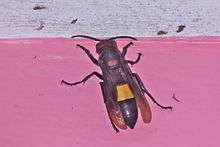Vespa tropica
| Greater banded hornet | |
|---|---|
 | |
| adult | |
_(8223186887).jpg) | |
| Nest | |
| Scientific classification | |
| Kingdom: | Animalia |
| Phylum: | Euarthropoda |
| Class: | Insecta |
| Order: | Hymenoptera |
| Family: | Vespidae |
| Genus: | Vespa |
| Species: | V. tropica |
| Binomial name | |
| Vespa tropica Linnaeus, 1758 | |
| Synonyms | |
| |
Vespa tropica, the greater banded hornet, is a tropical species of hornet found in Southern Asia, new Guinea and west Africa, and which has recently been discovered to be an invasive species on the Pacific Island of Guam. It is a predator of paper wasps.
Description
The workers of Vespa tropica are about 24–26 mm in length, while queens grow to 30 mm. The head is dark brown/red; the abdomen is black with a distinct yellow stripe which covers most of the second abdominal segment. However, there is some variation across its range and in Singapore and south-east Asia specimens are often completely black and larger in size, while in other regions such as Hong Kong the head and flanks of the thorax are normally reddish.[1][2] A third colour form is found in the Andamans and Nicobars which has a reddish brown head and thorax and all the dorsal plate on each segment of the gastrum are orange except the first.[3]
Distribution
Vespa tropica is distributed throughout southern Asia from Afghanistan to the Philippines,[2] south to New Guinea,[4] New Britain and the Torres Strait Islands but it has not been recorded in mainland Australia.[5]
Invasive
In August 2016 Vespa tropica was found at two sites in Guam,[2] and has since been deemed a permanent resident of the island's ecosystem, until a solution is found to exterminate them.[6]
Biology
Vespa tropica are raiders of the nests of other wasp species and take captured larvae back to their own nest to feed to their larvae. They have been observed to catch honeybees quite frequently, and even dragonflies have been noted as prey. A worker of V. tropica has been recorded as being captured and killed an individual of Vespa bicolor.[1] Vespa tropica is associated with forests in the lowlands, up to 2100m altitude.[7] The nests are usually within 3m above the ground in tree hollows or in subterranean cavities normally down to a depth of 20 cm including a record of one found inside a dead log partly buried in the soil. In the vicinity of human habitations it will nest under roofs, in attics and sheds. .[2][7] The nest is normally rhomboid or bowl-shaped and has an open bottom, whereas most aerial hornets' nest are completely sealed. The outer shell of the nest consists of distinct, broad layers and the nest is quite brittle. Occasionally nests are built within the crown of trees.[1] Predation by V. tropica is one of the foremost causes of colony failure in Polistes chinensis in Japan. V. tropica may play a significant role in controlling Asian polistene populations.[8] It can be a secretive species preferring to fly close to cover and often high among the crowns of trees.[1]
References
- 1 2 3 4 "Vespa tropica". Aculeates of Asia. vespa-bicolor.net. Retrieved 11 April 2017.
- 1 2 3 4 "The Greater Banded Hornet Has Found Its Way To Guam". CNAS News. College of Natural and Applied Sciences, University of Guam. Retrieved 12 April 2017.
- ↑ P. Girish Kumar; G. Srinivasan (2010). "Taxonomic studies of hornet waps (Hymenoptera: Vespidae) Vespa Linnaeus of India" (PDF). Records of the Zoological Survey of India. 110 (2): 57–80.
- ↑ P. Barss (1989). "Renal failure and death after multiple stings in Papua New Guinea. Ecology, prevention and management of attacks by vespid wasps. (abstract)". Medical Journal of Australia. 151 (11-12 Pages = 659-63).
- ↑ Joseph Bequeart (1936). "The common oriental hornets, Vespa tropica and Vespa affinis, and their color forms.". Treubia. 15 (4 Pages = 329-512).
- ↑ Shawn Raymundo (16 September 2016). "University of Guam scientists: Hornet eradication unlikely". Pacific Daily News. Retrieved 12 April 2017.
- 1 2 Michael E. Archer (2008). "Taxonomy, distribution and nesting biology of species of the genera Provespa Ashmead and Vespa Linnaeus (Hymenoptera, Vespidae)" (PDF). Entomologists' Monthly Magazine. 144 (1727): 69–101.
- ↑ Miyano, Shinya (1980). "Life tables of colonies and workers in a paper wasp, Polistes chinensis antennalis in central Japan". Population Ecology. 22: 69–88.